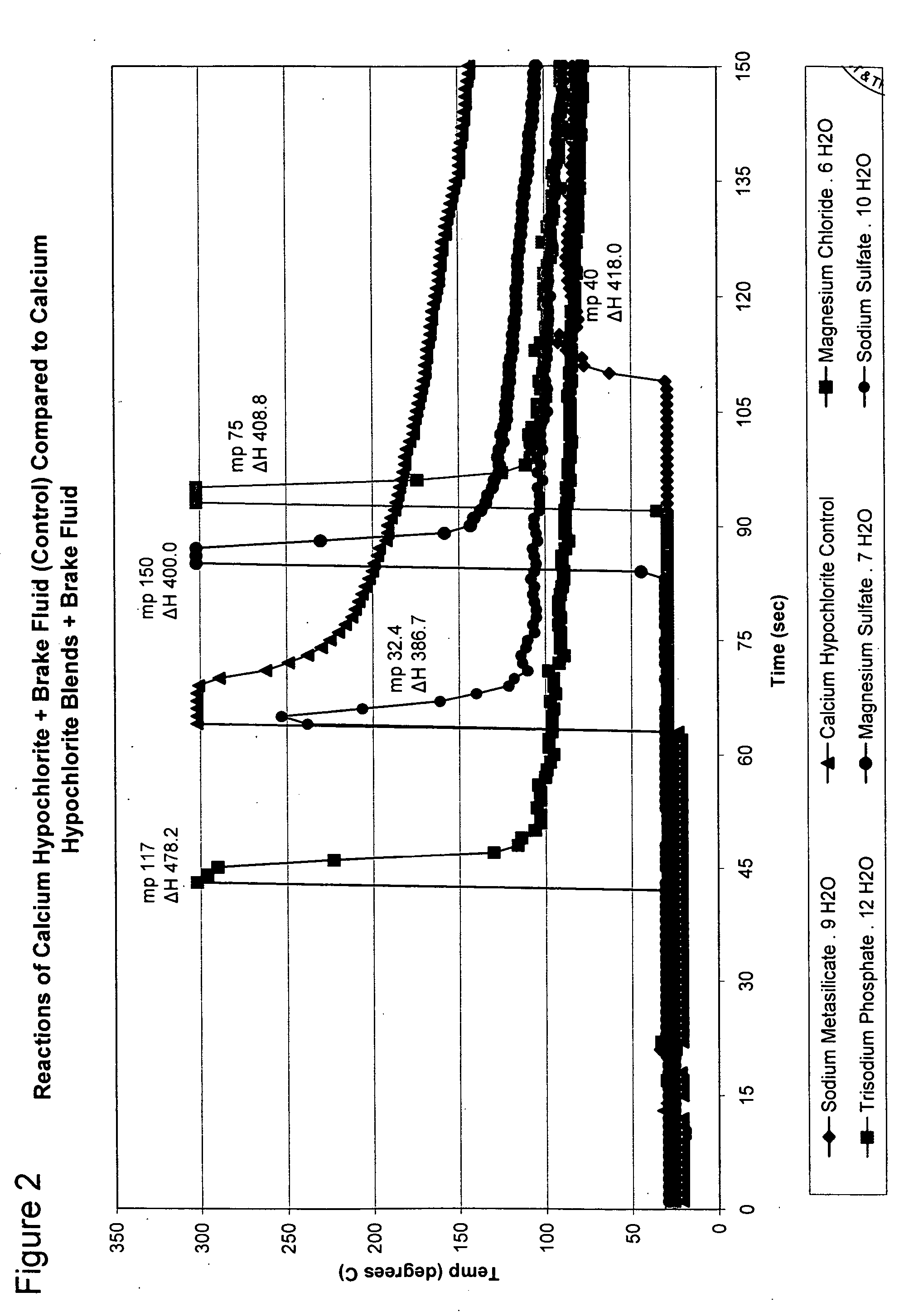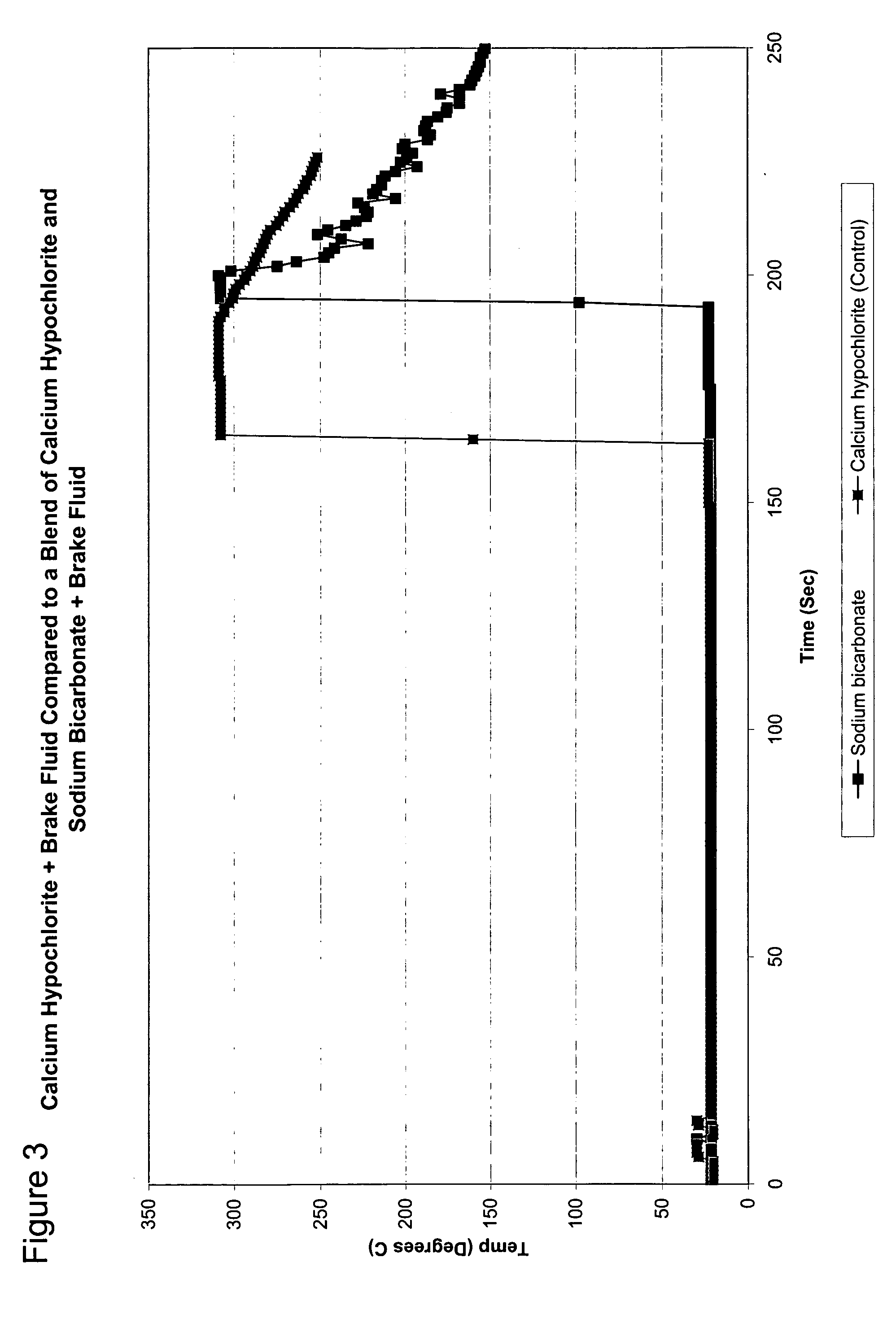Calcium hypochlorite compositions
a technology of compositions and calcium hypochlorite, which is applied in the direction of detergent compounding agents, halogen oxides/oxyacids, other chemical processes, etc., can solve the problems of major property damage and loss of life, adverse effect of cal hypo stability, and formation of calcium scal
- Summary
- Abstract
- Description
- Claims
- Application Information
AI Technical Summary
Problems solved by technology
Method used
Image
Examples
example 1
[0038]FIG. 1 shows the predictability of a single batch of calcium hypochlorite reacting with brake fluid. As described earlier, calcium hypochlorite reacts violently with Dot 3 brake fluid (Prestone) in a free radical depolymerization reaction of polyethylene glycol ether. The reaction of 50 grams of calcium hypochlorite and 10 milliliters (mls) of brake fluid is predictable for a given batch of calcium hypochlorite. Variations may occur with the reaction from different batches of cal hypo based on the attributes of the batch of calcium hypochlorite, such as age, moisture content and particle size.
[0039] The temperature measurement made in FIG. 1 was made with an IR thermometer with data acquisition software (Fisher Scientific). The temperature maximum of the thermometer is 300 degrees Celsius (C.). This maximum temperature is exceeded for the time period when the curve is flat at 300° C.
[0040]FIG. 2 shows the reaction of mixtures of various hydrated compounds blended with calciu...
example 2
[0042] Reducing the reactivity of calcium hypochlorite is only one aspect of the current invention. Few additives are even compatible with cal hypo. The inventive mixtures herein are also stable providing high available chlorine even after being subjected to conditions that have a degrading effect on the available chlorine present in calcium hypochlorite. Other aspects of the invention will also be made known.
[0043] As described earlier, cal hypo degrades over time. This is accelerated by the presence of heat and moisture. Inventive mixtures were stored at 40 degrees C. under ambient humidity conditions in a convection oven. These conditions would be indicative of potential warehouse and transport conditions for the material. Table 2 shows the increased chlorine stability of the inventive formulations.
[0044] Each 200 gram sample contained 70% (47% available chlorine) calcium hypochlorite, 2% Sodium tripolyphosphate hexahydrate, and the balance of the composition as shown below. Th...
example 3
[0046] Based on the results of Example 2, a simplified experiment on material consistency and product flowability was performed. Sodium tetraborate decahydrate was removed from the experiment. The 200 gram samples were composed of a fixed amount of potassium aluminum sulfate at a nominal concentration of 9% to provide benefits to the pool water while minimizing the effect on product flowability. The formulation contained 2% sodium tripolyphosphate hexahydrate and 70% calcium hypochlorite. Magnesium sulfate heptahydrate and trisodium phosphate dodecahydrate were formulated in different percentages to make up the final 19% of the formula. A control containing straight calcium hypochlorite was used as a base for comparison of flowability results. Samples were stored in a convection oven at 50° C. for 6 days under ambient humidity conditions. This temperature is indicative of possible short-term transport and storage conditions that a product may be exposed to. The results are shown in ...
PUM
 Login to View More
Login to View More Abstract
Description
Claims
Application Information
 Login to View More
Login to View More - R&D
- Intellectual Property
- Life Sciences
- Materials
- Tech Scout
- Unparalleled Data Quality
- Higher Quality Content
- 60% Fewer Hallucinations
Browse by: Latest US Patents, China's latest patents, Technical Efficacy Thesaurus, Application Domain, Technology Topic, Popular Technical Reports.
© 2025 PatSnap. All rights reserved.Legal|Privacy policy|Modern Slavery Act Transparency Statement|Sitemap|About US| Contact US: help@patsnap.com



